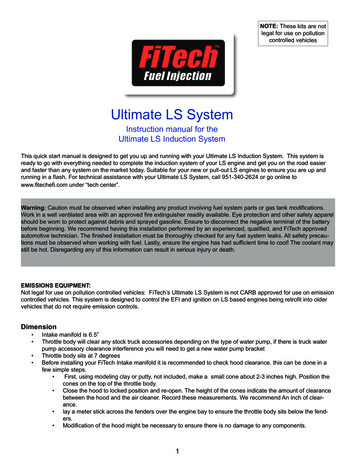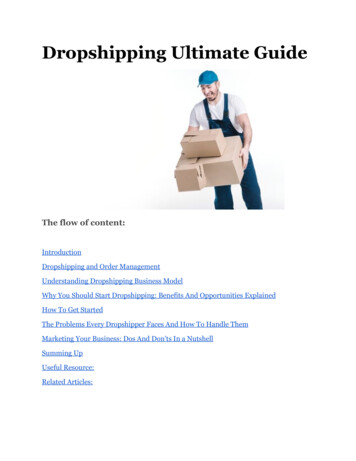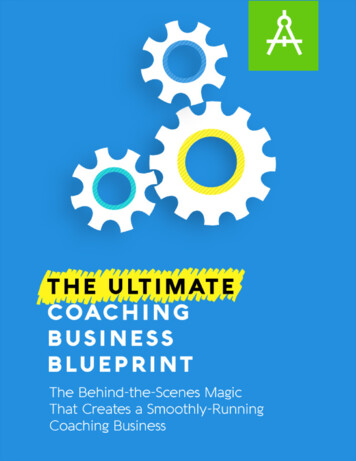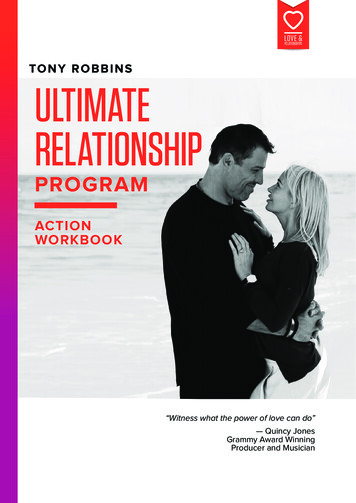
Transcription
theUltimatehealth foodsRay ComfortNewberry, FL 32669
ContentsIntroduction . . . . . . . . . . . . . . . . . . . . . . . . . . . . . . . vOne The Perfect Gift . . . . . . . . . . . . . . . . . . 1T w o Six Dangerous Side Effects . . . . . . . . . 9Three Resurrection Food . . . . . . . . . . . . . . . 21F o u r Another Vegan Nightmare . . . . . . . . . 31Fiv e Food of the Highest Order . . . . . . . . 43Six The Vilification of Salt . . . . . . . . . . . . 49Se v en Good Gifts . . . . . . . . . . . . . . . . . . . . . .57E igh t Life’s Staple Diet . . . . . . . . . . . . . . . . . 67N ine Unsatisfied Appetite . . . . . . . . . . . . . 75Ten Sticking to Chicken . . . . . . . . . . . . . . 87E le v en After Breakfast . . . . . . . . . . . . . . . . . 101T w elv e Divine Dining . . . . . . . . . . . . . . . . . . 113Thir teen Boosting Your Immune System . . . . 123Fourteen You’re Invited to Dinner . . . . . . . . . 137Notes . . . . . . . . . . . . . . . . . . . . . . . . . . . . . . . . . . . . 151Resources . . . . . . . . . . . . . . . . . . . . . . . . . . . . . . . . 154iii
IntroductionThe first time I visited Israel, I remember our tourguide telling us that the place we were about to visitwas either a “traditional” site or an “authentic” one.Traditional meant the Jesus may have been there.Authentic meant that He was there for certain. Forme, the difference was night and day. I was thoroughly bored with traditional sites, but loved standing on the shore of the Sea of Galilee and watchingthe sunrise, or walking through the ancient gates ofJerusalem, seeing the sites described in the Biblecome to life. Years later, I still have a deep sense ofjoy and satisfaction that I walked in the places Jesuswalked, and stood where He stood.What I discovered in the Bible about these foodshas added that same sense of joy and satisfaction tomy daily meals. I love knowing that I’m eating whatJesus ate or recommended. And I love knowing thatdespite many of these foods being vilified in thepast, it has come to Iight in recent years that everyone of them is beneficial to our health. The expertshad to eat their words.I hope that you will read this publication withthe same sense of discovery and excitement inv
viTHE ULTIMATE HEALTH FOODSwhich I wrote it. But keep in mind that this isn’t justa book about physical food. Man doesn’t live bybread alone (see Matthew 4:4). My hope is that thispublication gives you food for thought about thenourishment that really matters:“Do not labor for the food which perishes,but for the food which endures to everlastinglife ” (John 6:27)Best wishes,Ray Comfort
Chapter OneThe PerfectGiftOne of the most famous verses in the Bible predictsthe virgin birth of Jesus, the promised Messiah, butthe verse following it isn’t so well-known:“Therefore the Lord himself shall give you asign; Behold, a virgin shall conceive, and beara son, and shall call his name Immanuel.Butter and honey shall he eat, that he mayknow to refuse the evil, and choose thegood.” (Isaiah 7:14,15, KJV)According to this prophecy, written 800 yearsBC (Before Christ), Jesus would eat honey. Jesus wasalso given honey to eat when He appeared to Hisdisciples after His resurrection and asked them ifthey had any food:1
2THE ULTIMATE HEALTH FOODSSo they gave Him a piece of a broiled fishand some honeycomb. And He took it andate in their presence. (Luke 24:42,43)John the Baptist, the forerunner of Jesus, alsoate “locusts and wild honey” (Matthew 3:4)—perhaps the honey helped to counter the taste of thecrunchy insects. The Scriptures tell us that the wisest of men, King Solomon, recommended the consumption of honey to his son: “My son, eat honeybecause it is good, and the honeycomb which issweet to your taste” (Proverbs 24:13).Gratifying to the tastebuds, honey is a perfectgift to give when we want to express appreciation.Jacob told his sons to take honey with them to gainfavor with a highly influential man in Egypt:“Take some of the best fruits of the land inyour vessels and carry down a present for theman—a little balm and a little honey, spicesand myrrh, pistachio nuts and almonds.”(Genesis 43:11)When a queen visited the prophet Ahijah atShiloh, she was instructed to take a jar of honey inorder to gain his approval (1 Kings 14:3). Honeywas also included in the gifts given to King David’sarmy. At a time when they were hungry and wearyin the wilderness, they received “wheat, barley andflour, parched grain and beans, lentils and parchedseeds, honey and curds, sheep and cheese” to eat (2Samuel 17:27–29).
The Perfect Gift3Honey doesn’t just leave a good taste in themouth of those we wish to please, it is unique inthat it’s the only gift of food that doesn’t spoil. Meatrots, bread gets moldy, fruits decompose, nuts growstale, but honey doesn’t go bad:Natural, properly preserved honey will notexpire. In fact, archeologists found honeythousands of years old in ancient Egyptiantombs, and it was still good!1The book of Proverbs even equates honey withhealthy bones:Pleasant words are like a honeycomb, sweetness to the soul and health to the bones.(Proverbs 16:24)Easton’s Bible Dictionary says of honey:Canaan was a “land flowing with milk andhoney” (Exodus 3:8). Milk and honey wereamong the chief dainties in the earlier ages,as they are now among the Bedawin; andbutter and honey are also mentioned amongarticles of food (Isaiah 7:15). The ancientsused honey instead of sugar (Psalms 119:103;Proverbs 24:13); but when taken in greatquantities it caused nausea, a fact referred toin Proverbs 25:16, 17 to inculcate moderation in pleasures.2The metaphor of a “land flowing with milk andhoney” is used over twenty times in the Bible to
4THE ULTIMATE HEALTH FOODS
The Perfect Gift5describe abundance. The book of Job uses a similarphrase, describing rivers “flowing with honey andcream” (Job 20:17).In the book of Ezekiel, the Scriptures liken theWord of God to the sweetness of honey:And He said to me, “Son of man, feed yourbelly, and fill your stomach with this scrollthat I give you.” So I ate, and it was in mymouth like honey in sweetness. (Ezekiel 3:3)Health Benefits of Raw Honey Dioscorides, an ancient Greek physician, wroteabout honey’s healing properties. He recognized that it can heal burns and spots on theface, as well as inflammation in the throat andtonsils. Honey has proven to be a more effective cough treatment than some cough medications. It’s also a great source of energy with only 17grams of carbohydrates in one teaspoon. It actsas an energy booster since its glucose and fructose enter directly into the bloodstream.Additionally, honey aids athletic performancebecause it maintains blood sugar levels thathelp muscle recuperation after workouts. Honey is a great allergy reliever. Small amountsof pollen, which is used to produce it, triggerthe immune system to produce antibodies topollen, decreasing allergic reactions.
THE ULTIMATE HEALTH FOODS6 Honey is a great natural antiseptic, because itslowly releases hydrogen peroxide, an antibacterial, antimicrobial, and antiseptic compoundthat can kill germs, disinfect a wound, and healbroken skin. Honey applied to a wound keepsit moist and acts as a protective barrier againstinfection, making it very effective in treatingcuts, burns, bug bites, yeast infections, eczema,acne, dandruff, and fungal infections. It helps to eliminate free radicals and toxinsfrom the body, boosting the immune system.Free radicals are molecules that the body produces when it breaks down food or encounterspollutants. These can damage the body’s cellsand contribute to disease. It can help with weight management and losswhen consumed in moderation with lemonand/or cinnamon because it contributes to thedigestion of stored fat in the body. Honey’s glycemic index (a measure that determines howfast food raises sugar levels) is 54–59, whereasother sugar forms can reach as high as 105. Honey is full of antioxidants, including organicacids and phenolic compounds, which help tostabilize free radicals. Honey helped lower LDL (bad cholesterol) andraised HDL (good cholesterol) during an eightweek clinical trial on diabetic patients. Fur thermore, a 2013 study showed that consum-
The Perfect Gift7ing honey daily for twelve weeks improved themetabolism in type 1 diabetes patients. It promotes heart health because of its positiveeffects in lowering blood pressure, cholesterol,and triglyceride levels. It releases serotonin in the body, which is aneurotransmitter that improves mood andhappiness. The body then converts the serotonin into melatonin, known as the sleep hormone, that regulates the sleep-wake cycle, controlling the length and quality of sleep. Honey, particularly tualang honey, proved in a2015 review of studies that it improves learning and memory processes. It enhances brainareas related to memory, decreases oxidativestress in the brain, and increases brain growthfactors. It has also proven to be helpful to boost theshort-term memory of post-menopausal wo men. A 2011 study showed that after fourmonths of daily taking 20 grams of honey,these women had better short-term memorythan those who took hormone pills to fight ahormone-related intellectual decline. The Mayo Clinic affirms, “Studies suggest thathoney might offer antidepressant, anticonvulsant and anti-anxiety benefits. In some studies,
8THE ULTIMATE HEALTH FOODShoney has been shown to help prevent provement in immediate memory after 16 weeks of tualang honeyAgro Mas supplement in healthy rt20363819Tasteful Quote“If you want to gather honey, don’t kick overthe beehive.” —Dale Carnegie
Chapter TwoSix DangerousSide EffectsAs we have seen in the previous chapter, the Bibletells us that Jesus ate butter along with honey:“Butter and honey shall he eat, that he mayknow to refuse the evil, and choose thegood.” (Isaiah 7:15)But how could Jesus have eaten something thatexperts have found to be a major cause of heart disease? Surely as God in human form (see 1 Timothy3:13), Jesus knew that butter is damaging to humanhealth. An article titled “6 Dangerous Side Effects ofEating Too Much Butter, According to Experts”warns:“Butter is high in saturated fat. A tablespoonhas about seven grams, which is about onethird of your daily recommended allowance,”explains Leann Poston MD, MBA, MEd.9
10THE ULTIMATE HEALTH FOODS
Six Dangerous Side Effects11“Eating a diet high in saturated fats increasesyour LDL (‘bad’) and HDL cholesterol.Increased LDL cholesterol can contribute toatherosclerosis and atherosclerosis canincrease your risk for blood clots, strokes,and heart attacks.”3However, in another article titled “Is Butter aHealthy Fat?” Scientific American has some goodnews for butter lovers:Johanna writes: “I was recently surprised tohear a nutritionist encourage people to usebutter, calling it a healthy fat. I’ve alwaysavoided butter because of the saturated fat.Yet, a quick online search shows multiplearticles saying butter is making a comebackas a healthy fat. Can this be true?”It’s true that butter contains saturatedfat. It’s also true that saturated fat’s reputation as an artery clogger has been undergoing some rehabilitation in recent years. Dietsthat are high in saturated fat can raise yourcholesterol levels. But . . . the links betweensaturated fat, cholesterol, and heart diseaseare a lot more complex than we oncethought. In fact, having some saturated fat inyour diet may actually be good for your heartand other organs.4The Harvard Public Health Magazine reportedsimilar good news. Based on findings in the Annalsof Internal Medicine, “eating less saturated fat, the
12THE ULTIMATE HEALTH FOODSdietary demon that makes buttery croissants so irresistible, doesn’t actually lower a person’s risk forheart disease.” The Harvard article continues:The finding was reported widely in themedia, hitting all the cultural hot buttons:food and fat, death and disease, bacon andBrie. As Mark Bittman’s column in The NewYork Times rhapsodized: “Butter is Back. JuliaChild, goddess of fat, is beaming somewhere.”5I Can’t Believe It’s Not BetterWhen butter got a bad battering, the good newsabout a lookalike called “margarine” spread likewildfire. But hold your horses. The lookalike may bean imposter. Check this heart-stopping information:Don’t let that heart-healthy checkmark onthe packaging fool you—not only is margarine no better for you than butter, it mayactually be increasing your risk of cardiovascular disease.6The truth is, there never was any good evidence that using margarine instead of buttercut the chances of having a heart attack ordeveloping heart disease. Making the switchwas a well-intentioned guess, given that margarine had less saturated fat than butter, butit overlooked the dangers of trans fats.7
Six Dangerous Side Effects13Butter was labeled a bad food choice in thepast because of its high saturated fat content.Various health experts started promotingmargarine instead. Back in the day, margarine used to be high in trans fats. These days,it has fewer trans fats than before, but it’s stillloaded with refined vegetable oils.Not surprisingly, the Framingham HeartStudy showed that people who replace butterwith margarine are actually more likely todie from heart disease.8Health Benefits of ButterAuthors Sally Fallon and Mary G. Enig, PhD, ex plain the benefits of this creamy spread in “WhyButter Is Better”:Heart disease was rare in America at the turnof the century. Between 1920 and 1960, theincidence of heart disease rose precipitouslyto become America’s number one killer.During the same period butter consumptionplummeted from eighteen pounds per person per year to four. It doesn’t take a Ph.D. instatistics to conclude that butter is not acause. Actually butter contains many nutrients that protect us from heart disease. Firstamong these is vitamin A which is neededfor the health of the thyroid and adrenalglands, both of which play a role in maintaining the proper functioning of the heartand cardiovascular system. Abnormalities of
14THE ULTIMATE HEALTH FOODSthe heart and larger blood vessels occur inbabies born to vitamin A deficient mothers.Butter is America’s best and most easilyabsorbed source of vitamin A.Butter contains lecithin, a substance thatassists in the proper assimilation and metabolism of cholesterol and other fat constituents.Butter also contains a number of antioxidants that protect against the kind of freeradical damage that weakens the arteries.Vitamin A and vitamin E found in butterboth play a strong anti-oxidant role. Butter isa very rich source of selenium, a vital antioxidant—containing more per gram thanherring or wheat germ.Butter is also a good dietary source [of]cholesterol. What? Cholesterol an anti-oxidant? Yes indeed, cholesterol is a potentanti-oxidant that is flooded into the bloodwhen we take in too many harmful free-radicals—usually from damaged and rancid fatsin margarine and highly processed vegetableoils. A Medical Research Council surveyshowed that men eating butter ran half therisk of developing heart disease as thoseusing margarine.9Butter has other health benefits as well: It can help lower your chances of cancer. Butteris high in beta-carotene, a compound that yourbody converts into vitamin A. Beta-carotene is
Six Dangerous Side Effects15what gives butter its yellow color and has beenlinked to lowered risks of lung cancer andprostate cancer. It is an excellent source of nutrients such as fat,vitamin A, vitamin E, vitamin B-12, vitamin K,vitamin B2, phosphorus, and calcium. Butter is a powerful antioxidant because of itshigh levels of carotene. About 60% of caroteneintake is transformed into disease-fightingcompounds, providing a boost to the immunesystem. Carotene is also transformed in vitamin A which is fat-soluble, helping the parts ofthe body with membranes such as the eyes,skin, mouth, and the urinary and digestivetracts. Vitamin A promotes cell growth andreparation, and encourages the production oflymphocytes—the defensive cells that fightagainst viruses and autoimmune diseases. The high levels of vitamin A and carotene havebeen proven to work as anti-cancer agents.They work together against cancerous growthand promote spontaneous cell death (apoptosis) in tumors. The coagulated linoleic acid(CLA) is found in significant levels in butter,reducing the chances of getting cancer. Butter’s good amount of beta carotene helps toprotect the eyes, slow the development of cataracts, reduce the risk of macular degeneration,
16THE ULTIMATE HEALTH FOODSand decrease other eye conditions as well asangina pectoris. It contains high levels of glycospingolipids thatprotect the intestines and increase the defensesin the stomach. Butter and other high-fat dairy products cannot be linked with cardiovascular diseases. Infact, research has shown that high-fat dairyproducts can be beneficial for cardiovascularhealth. The National Library of Medicinestates, “Despite the contribution of dairy products to the saturated fatty acid composition ofthe diet, and given the diversity of dairy foodsof widely differing composition, there is noclear evidence that dairy food consumption isconsistently associated with a higher risk ofCVD.” Butter’s vitamin A is essential in the development and growth of children. A lack of vitaminA during gestation can lead to narrow facesand skeletal structure, crowded teeth, andsmall palates. Butter has more vitamin A than any other typeof vitamin, which is important for a healthythyroid. Hypothyroidism and other thyroiddiseases are linked to a lack of vitamin A, causing an imbalance in the rest of the endocrinesystem.
Six Dangerous Side Effects17 Butter’s high cholesterol helps the brain andnervous system to develop properly, especiallyin growing children. The brain produces itsown cholesterol but also pulls it from theblood’s plasma which comes from the diet. Butter and cream carry a unique hormone-likesubstance called Wulzen Factor, which helps toprevent the calcification of the joints that leadsto arthritis. It also protects from hardenedarteries and the calcification of the pinealgland. However, the pasteurization of milk,cream, and butter removes the Wulzen Factor.It is interesting that baby calves that are given asubstitute without the Wulzen Factor do notsurvive. It is rich in essential minerals, like manganese,zinc, copper, and selenium. These elements arevery important to the bones’ health, supporting bone repair and growth. Arthritis andosteoporosis can be prevented with a healthybutter .nih.gov/19259609/dairy.com.au/products/butter
18THE ULTIMATE HEALTH FOODSHow Butter Is MadeMost of the butter we eat is made from cow’s milk,and occasionally goat’s milk, but that’s not the casethroughout the world. In other countries butter canalso be made from the milk of sheep, camels, reindeer, water buffalo, llamas, yaks, and even horses.Many of us as children gave butter making a tryin a school class, learning about how the pioneerslived. Churning cream or whole milk in a woodenbutter churn is a good way to develop patience, andmuscles.According to Britannica.com,Butter making was developed centuries ago.Ancient Sanskrit writings and the oldestbooks of the Bible mention the use of butter.Butter once was used as a cosmetic and tonicfor the hair and skin. The Greeks and Ro mans used it as a medicine.Primitive churns were made of hollowlogs or leather bags that were swung fromtrees to create churning action. Butter wasalso made by beating milk in a bowl. Laterchurns were made of jars with wooden dashers.In the United States butter making wasprimarily a household activity until the late1800s. After the development of cream separators, creameries began to appear. Cream eries performed the butter-making labor onthe farm and stimulated greater demand forbutter in the cities. With modern production
Six Dangerous Side Effectsmethods and transportation, butter can beshipped thousands of miles and can bestored for months without losing its flavorand quality.10Tasteful Quote“If you’re afraid of butter, use cream.”—Julia Child19
20THE ULTIMATE HEALTH FOODS
Chapter ThreeResurrectionFoodAfter Jesus died on the cross and then rose from thedead, much to the joy of His disciples, He appearedto them and asked a question: “Have you any foodhere?” While they were still marveling, they “gaveHim a piece of a broiled fish and some honeycomb.And He took it and ate in their presence” (Luke24:41–43).Jesus not only ate fish, He cooked it for His disciples:Then, as soon as they had come to land, theysaw a fire of coals there, and fish laid on it,and bread. Jesus said to them, “Bring some ofthe fish which you have just caught.” (John21:9,10)There are some who find that very hard to swallow, as in this article from PETA:21
22THE ULTIMATE HEALTH FOODSIf you’re a Christian who follows a vegetarianor vegan diet, you may have heard this defensive response from fellow meat-eating believers: “But Jesus wasn’t a vegan. He ate fish!”Although there are stories throughout theBible that appear to suggest that Jesus atefish, there has been serious theologicaldebate as to whether he actually did or if theword “fish” is a mistranslation.11If the word “fish” is a mistranslation, then thepreceding verse in the same passage of Scriptureneeds to be changed. It says,And He said to them, “Cast the net on theright side of the boat, and you will findsome.” So they cast, and now they were notable to draw it in because of the multitude offish. (John 21:6)Jesus told these fishermen to cast their fishingnets on the right side of their boat—because theyhad fished all night and hadn’t caught any fish. If itwas a mistranslation, when they pulled their net init must have been filled to overflowing with something else. What was the mysterious something else?Fortunately, thanks to another vegan site, we’re notleft floundering: “the Greek word translated ‘fish’may actually refer to dried seaweed as some scholarsbelieve ”12
Resurrection Food23So that we can see the context of this incident,here it is directly from the Bible (New King JamesVersion):Simon Peter said to them, “I am going fishing.”They said to him, “We are going with youalso.” They went out and immediately gotinto the boat, and that night they caughtnothing. But when the morning had nowcome, Jesus stood on the shore; yet the disciples did not know that it was Jesus. ThenJesus said to them, “Children, have you anyfood?”They answered Him, “No.” And He saidto them, “Cast the net on the right side of theboat, and you will find some.” So they cast,and now they were not able to draw it inbecause of the multitude of fish.Therefore that disciple whom Jesus lovedsaid to Peter, “It is the Lord!” Now whenSimon Peter heard that it was the Lord, heput on his outer garment (for he had re moved it), and plunged into the sea. But theother disciples came in the little boat (forthey were not far from land, but about twohundred cubits), dragging the net with fish.Then, as soon as they had come to land, theysaw a fire of coals there, and fish laid on it,and bread. Jesus said to them, “Bring some ofthe fish which you have just caught.”
24THE ULTIMATE HEALTH FOODSSimon Peter went up and dragged thenet to land, full of large fish, one hundredand fifty-three; and although there were somany, the net was not broken. Jesus said tothem, “Come and eat breakfast.” Yet none ofthe disciples dared ask Him, “Who areYou?”—knowing that it was the Lord. Jesusthen came and took the bread and gave it tothem, and likewise the fish. (John 21:3–13)Here now is my own paraphrase of John 21:3–13 from The New Vegan Version*:Peter was going fishing, and so the disciplesfollowed him. They fished all night andcaught nothing. In the morning Jesus stoodon the shore and asked if they caught anything. When they said that they hadn’tcaught any fish, He told them, “Cast the neton the right side of the boat, and you willfind some.” They did what He had told themto do, and were not able to pull the net inbecause of the amount of dried seaweed thatcame up from the wet ocean. The miraculouscatch confirmed to Peter that it was the Lord,and so he dived into the sea to go to Jesus.The other disciples followed him in the boat,and then dragged the net filled with thedried seaweed.But Jesus didn’t apologize for it beingseaweed rather than the fish He’d promised.* There is no such thing as The New Vegan Version of the Bible.This is purely satire.
Resurrection Food25Instead, He gave them dried seaweed to eatfor breakfast that He’d already been cookingon the fire. Jesus then told them to bring inthe remaining seaweed, and Peter dragged itcloser. It contained one hundred and fiftythree large pieces.For those who are interested in reality, the Greekword used in this passage to describe the catch istransliterated opsarion, and is translated “fish.”13Feeding the MultitudesJesus also miraculously multiplied fish on two different occasions to feed hungry crowds (Matthew14:14–21 and 15:32–38).Now Jesus called His disciples to Himself andsaid, “I have compassion on the multitude,because they have now continued with Methree days and have nothing to eat. And I donot want to send them away hungry, lest theyfaint on the way.”Then His disciples said to Him, “Wherecould we get enough bread in the wildernessto fill such a great multitude?”Jesus said to them, “How many loaves doyou have?”And they said, “Seven, and a few littlefish.”So He commanded the multitude to sitdown on the ground. And He took the sevenloaves and the fish and gave thanks, broke
26THE ULTIMATE HEALTH FOODSthem and gave them to His disciples; and thedisciples gave to the multitude. So they all ateand were filled, and they took up seven largebaskets full of the fragments that were left.Now those who ate were four thousand men,besides women and children. (Matthew15:32–38)On the other occasion He fed five thousandmen, plus women and children. He could havemiraculously created any food to give to the famished multitude, but along with bread He providedfish, a healthy protein to satisfy their hunger andnourish their bodies.Fish in Bible TimesThe Israelites ate a variety of fresh and saltwater fish, according to both archaeologicaland textual evidence. Remains of freshwaterfish from the Yarkon and Jordan rivers andthe Sea of Galilee have been found in excavations Fishermen supplied fish to inlandcommunities, as remains of fish, includingbones and scales, have been discovered atmany inland sites. To preserve them fortransport, the fish were first smoked or driedand salted.14Health Benefits of Fish Fish is one of the healthiest foods in the world,with its many important nutrients, high-quality
Resurrection Food27proteins, iodine and other minerals and vitamins. It is an excellent source of omega-3 fattyacids, which are very important for our brainsand reduce inflammation. It is a great source of protein without the highsaturated fat is found in other types of meat. Fatty fish, such as salmon, trout, sardines, tuna,and mackerel, are considered to be the healthiest because of their omega-3 and vitamin Dcontent. Most people lack these nutrients,which are known to prevent many diseases. It reduces the risk of heart attacks and strokes,the two most common causes of prematuredeath. Studies have shown that people whoconsume fish regularly have a lower risk ofheart attacks, strokes, and heart diseases ingeneral. The American Heart Association recommends two servings of fish per week. Fish helps in reducing the bad cholesterol levelin the body, according to the Baylor UniversityMedical Center Proceedings. According to a review published by the Amer ican Journal of Cardiology, “The results indicatethat fish consumption is associated with a significantly lower risk of fatal and total coronaryheart disease (CHD). These findings suggestthat fish consumption may be an importantcomponent of lifestyle modification for theprevention of CHD.”
28THE ULTIMATE HEALTH FOODS Omega-3 is essential for growth and development. It is recommended that pregnant andbreastfeeding women include 340 grams ofsalmon, sardines, or trout (low-mercury fish)per week as a source of omega-3, which is veryimportant for the brain and eye development. Fish can help in delaying the normal mentaldecline that comes with aging, as well as prevent serious neurodegenerative conditions likeAlzheimer’s disease. Those who eat fish weeklyhave more gray matter, which is the brain’smajor functional tissue responsible for memory and regulating emotions. Fish has proved to help in preventing low mood,decreased energy, and depression. Omega-3helps to fight depression, mental conditions,and bipolar disorder, and enhances the effectiveness of antidepressant medications. Fatty fish like salmon and herring are a greatsource of vitamin D, which is lacking in over40% of Americans. A single serving (113 grams)of cooked salmon contains 100% of recommended daily intake of vitamin D. A tablespoon of fish oil, such as cod liver oil, provides200% of the recommended daily vitamin D. Vitamin D deficiency is linked to sleep disorders. A study among 95 middle-aged menshowed that consuming salmon three times aweek improved sleep and daily functioning.
Resurrection Food29 Fish reduces the risk of type 1 diabetes in children and of autoimmune disease in adults,because of its omega-3 fatty acids. In children,fish also reduces the risk of asthma by 24%. Regular fish consumption is linked to a 42%lower risk of age-related macular degeneration(AMD) that causes vision impairment
The book of Proverbs even equates honey with healthy bones: Pleasant words are like a honeycomb, sweet-ness to the soul and health to the bones. (Proverbs 16:24) Easton’s Bible Dictionary says of honey: Canaan was a “land flowing with milk and honey” (Exodus 3:8). Milk and honey











